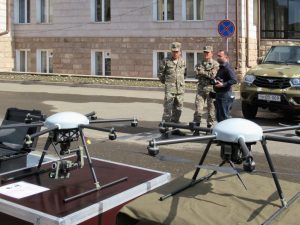The news in the last few weeks has been replete with examples of armed forces testing each other’s boundaries. Iranian speedboats sailed close to U.S. Navy and U.S. Coast Guard ships operating in the Persian Gulf, causing the American ships to fire warning shots. China’s maritime militia gathered at Whitsun Reef to put muscle behind Beijing’s territorial claims. And Russia assembled a plethora of military forces on its border with Ukraine, prompting alarmed reactions from Western observers.
This is, of course, well-trodden territory. Sailing warships, assembling ground forces, or flying aircraft close to disputed borders is a longstanding practice with several purposes: improving readiness, communicating capability, and warning adversaries of red lines. But these activities have another impact, which will only grow with the wider adoption of novel military technologies: generating annoyance.
“Annoyance” is not a word which is commonly found in the strategic studies literature. It is, especially at the institutional level, hard to define precisely (though older siblings and parents of small children are likely to have a much stronger and more intuitive familiarity with it). But while it may not be a particularly important strategic concept yet, I suspect its time is soon to come.
Let me explain. One of the fundamental problems with the types of boundary-probing operations as listed above is that they are inherently risky. Collisions between ships, submarines, and aircraft happen, often with fatal consequences. Nor are collisions the only risk. In times of heightened tensions, boundary-testing can lead directly or indirectly to deadly mistakes or escalatory spirals.
Some of these risks, at least, can be mitigated with the use of remotely piloted or autonomous systems. Such systems do not eliminate risk entirely, but their losses are much more politically and strategically manageable. Even large, expensive remote systems, like the American RQ-4 Global Hawk shot down by Iran in 2019, do not create the same kind of political pressure for revenge, as Iran discovered when former President Trump ordered and then cancelled a retaliatory strike, reasoning publicly that the loss of a drone didn’t warrant lethal retribution.
That quality of expendability has, of course, been explored at length, though conclusions vary. To some observers, expendable drones which can loiter near a target for extended periods without much risk limit the likelihood of error and allow strikes to be carried out with the minimum possible harm to non-targets. Others suggest that lowering the risk of carrying out a strike makes it much easier – politically, operationally – and creates more aggregate violence without an attendant strategic benefit.
Those debates tend to focus on lethal violence; the actual application of weapons to targets. And as remotely piloted and autonomous systems become cheaper, more capable, and more widespread, their ability to undertake other kinds of missions will increase. Drones are already heavily used for surveillance and communications but seeing them as simply binary tools capable of either passive reconnaissance on the one hand or strike missions on the other reflects a lack of imagination.
Rather, it is precisely in the blurred middle area between kinetic and non-kinetic use cases where we can find the enormous growth potential for what might be termed “strategic annoyance.” Where a fighter jet or a warship or a platoon of soldiers crossing a border is likely to be perceived as a hostile act – if not an outright declaration of war – a drone, especially a smaller, less threatening one can do so and only receive a more muted response. It may well be destroyed, but that, too, can have a purpose. Often the weapons used to shoot down small drones are considerably more expensive than their targets.
Repeat enough times, or at unpredictable enough intervals, and defenders will have to be on alert constantly. There is a balance to be struck, of course. Pushing boundaries in a manner that could be mistaken for a real attack poses the risks of escalation and also gives defenders an insight into the attacker’s plans in the event of conflict. But small drones, used unpredictably, could conceivably force defenders to adopt a wearying posture of constant readiness and uncertainty, without posing much risk of uncontrolled escalation.
There are a few lower-technology analogues for this strategy. In the 1960s, NATO tested a novel anti-submarine weapon: a planeload of hinged magnets that could be dropped in the vicinity of a Soviet submarine, sticking to its hull and creating a racket that made it trivially easy to track with sonar. The key was that doing so did not endanger the lives of the Soviet sailors; it simply degraded their ability to hide. Unfortunately, the magnets were a victim of their own success. They were so difficult to remove that it was impractical to train on allied submarines with them, and they were retired and nearly forgotten.
But autonomous technology, in all its forms, offers much more flexibility. Where the magnets had a single use-case, drones have already proven much more adaptable. And given the low barriers to entry – and their documented modification and use by a range of non-state actors – it would be a mistake to assume that they, and related technologies, will always be used in established categories recognizable to established militaries. Their use for strategic annoyance may or may not turn out to be significant. But it is worth considering the other ways they might be used to creatively transcend boundaries for strategic advantage.

































